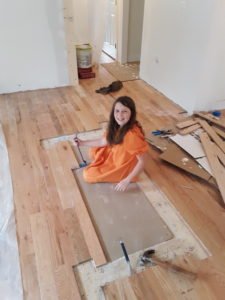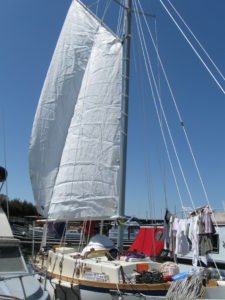
For the last, oh, more than a year now, the realization has been growing that it’s been a long time since I wrote a blog post. And for the past few months I’ve been meaning to sit down and write one, and even while at work muttered punch lines to myself under my breath—you know, that final sentence that ties the whole piece together and leaves the reader looking expectantly for the next post. Then in the last few days several of my readers have emailed to wonder if I’m ever going to write again, and have I died or what?

The truth is, dear readers all, that for the past year and a half I simply haven’t had anything to write about. We have been so busy with the purchase of an unfinished house to work on that seafaring has taken a back burner in our attention, if never in our hearts. I considered blogging about the house project, which turned out gargantuan beyond imagination. But this is a sailing blog, and postings about vinyl siding, windows, and drywall would be out of place in this temple to salt spray and waves and tillers and sails. Besides, a house is really only a place from which to stage your next voyage, and maybe keep some stuff dry while you’re away. It’s not interesting in itself, like a boat is.
But now it’s spring again, boat season is approaching. I’ve been out removing Ganymede’s winter cover and spiffing her up for the year, and perhaps I even have something to write about.

This winter was unusual in that we didn’t do a bottom job—last season’s very thorough sanding and antifouling application still looked good as new when Ganymede got hauled in the fall. We had tried something new by not simply rolling bottom paint (hard—I never use ablative) around with a long-nap roller as usual. This time I had a helper follow after with a dry foam roller to ‘tip’ the paint, which resulted in a finish so smooth it might have been sprayed. The hot dog rollers would eventually soak up paint and fall apart, so we went through several per side, but the result was worth it as there were less crannies in which the sea life could take a hold.
What I did do this winter was continue to upgrade and fine-tune Ganemede’s rigging. Splicing and ropework have always seemed like the pinnacle of seafaring skill to me; an essential to a tidy, efficient, well-ordered boat. The alert reader will remember that Ganymede’s standing rigging is Vectran with polyester covers. It was chosen not only because it’s impervious to the molecular ‘creep’ which plagues the more popular Dyneema, but because it was a lot cheaper. Its big disadvantage is that it degrades alarmingly in sunlight—and rumor had it that a cover only slows the degradation, but is not proof against it.

The rigging shop where I do much of my work as a subcontractor has a test bench—a ten ton hydraulic puller used for pre-stretching and load testing. It’s also useful for breaking old shrouds to see how much life was left in them. Some of Ganymede’s old ropes broke with interesting results. The first piece—a fuzzy yellow bit of uncovered Vectran that had been a bucket lanyard for ten years snapped at one-third of it’s rated BL (break load). But that was expected. A piece of covered Vectran that had sat out for the same decade broke at around 6,000#; just under half of its original BL. The third piece, a second generation jibstay less than four years old, broke at 11,000#; originally it was rated to just over 15,000.

Now while that strength reduction seems alarming, the overspec of the rigging means that even in the original gang there still remains enough strength for Ganymede’s low-aspect ratio gaff rig. She’s on her second gang of rigging, changed out not because the original was faulty, but because I upgraded from galvanized turnbuckles to deadeyes and lanyards. Now that second gang is getting slowly changed out, but with no real urgency—just piece by piece as time and budget allow. There are new flavors of Dyneema now—stronger and with less creep, which I’ve begun to incorporate and will keep an eye on. So the bobstay and bowsprit shrouds are SK99 Dyneema, with Dyneema covers. For the gaff span wire some regular SK78 with cover, and finally for this year a new jibstay using the last of the bargain basement Vectran.

I’m afraid there are no pictures yet of all these things installed: launch date is still a few weeks away, and I can’t ship the bowsprit until the boat’s in the water. But every nice day between now and then, if you happen by the boatyard, chances are you’ll see me with at least one of my daughters, waxing the hull, fiddling with the rig, and longing to hear the ripple of water under her stem as the water turns from green to blue.




